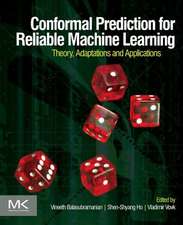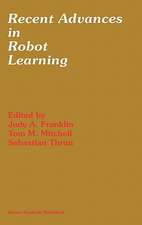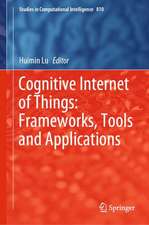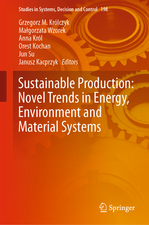Machine Learning: An Artificial Intelligence Approach (Volume I)
Autor Ryszard S. Michalski, Jaime G. Carbonell, Tom M. Mitchellen Limba Engleză Hardback – 1955
| Toate formatele și edițiile | Preț | Express |
|---|---|---|
| Paperback (1) | 1620.55 lei 6-8 săpt. | |
| Springer Us – 14 oct 2011 | 1620.55 lei 6-8 săpt. | |
| Hardback (2) | 500.39 lei 6-8 săpt. | |
| ELSEVIER SCIENCE – 1955 | 500.39 lei 6-8 săpt. | |
| Springer Us – 30 apr 1986 | 1633.95 lei 6-8 săpt. |
Preț: 500.39 lei
Preț vechi: 625.49 lei
-20% Nou
Puncte Express: 751
Preț estimativ în valută:
95.75€ • 100.22$ • 79.69£
95.75€ • 100.22$ • 79.69£
Carte tipărită la comandă
Livrare economică 31 martie-14 aprilie
Preluare comenzi: 021 569.72.76
Specificații
ISBN-13: 9780934613095
ISBN-10: 0934613095
Pagini: 572
Dimensiuni: 152 x 229 x 33 mm
Greutate: 0.96 kg
Editura: ELSEVIER SCIENCE
ISBN-10: 0934613095
Pagini: 572
Dimensiuni: 152 x 229 x 33 mm
Greutate: 0.96 kg
Editura: ELSEVIER SCIENCE
Cuprins
Preface
Part One General Issues in Machine Learning
Chapter 1 An Overview of Machine Learning
1.1 Introduction
1.2 The Objectives of Machine Learning
1.3 A Taxonomy of Machine Learning Research
1.4 An Historical Sketch of Machine Learning
1.5 A Brief Reader's Guide
Chapter 2 Why Should Machines Learn?
2.1 Introduction
2.2 Human Learning and Machine Learning
2.3 What is Learning?
2.4 Some Learning Programs
2.5 Growth of Knowledge in Large Systems
2.6 A Role for Learning
2.7 Concluding Remarks
Part Two Learning from Examples
Chapter 3 A Comparative Review of Selected Methods for Learning from Examples
3.1 Introduction
3.2 Comparative Review of Selected Methods
3.3 Conclusion
Chapter 4 A Theory and Methodology of Inductive Learning
4.1 Introduction
4.2 Types of Inductive Learning
4.3 Description Language
4.4 Problem Background Knowledge
4.5 Generalization Rules
4.6 The Star Methodology
4.7 An Example
4.8 Conclusion
4.A Annotated Predicate Calculus (APC)
Part Three Learning in Problem-Solving and Planning
Chapter 5 Learning by Analogy: Formulating and Generalizing Plans from Past Experience
5.1 Introduction
5.2 Problem-Solving by Analogy
5.3 Evaluating the Analogical Reasoning Process
5.4 Learning Generalized Plans
5.5 Concluding Remark
Chapter 6 Learning by Experimentation: Acquiring and Refining Problem-Solving Heuristics
6.1 Introduction
6.2 The Problem
6.3 Design of LEX
6.4 New Directions: Adding Knowledge to Augment Learning
6.5 Summary
Chapter 7 Acquisition of Proof Skills in Geometry
7.1 Introduction
7.2 A Model of the Skill Underlying Proof Generation
7.3 Learning
7.4 Knowledge Compilation
7.5 Summary of Geometry Learning
Chapter 8 Using Proofs and Refutations to Learn from Experience
8.1 Introduction
8.2 The Learning Cycle
8.3 Five Heuristics for Rectifying Refuted Theories
8.4 Computational Problems and Implementation Techniques
8.5 Conclusions
Part Four Learning from Observation and Discovery
Chapter 9 The Role of Heuristics in Learning by Discovery: Three Case Studies
9.1 Motivation
9.2 Overview
9.3 Case Study 1: The AM Program; Heuristics Used to Develop New Knowledge
9.4 A Theory of Heuristics
9.5 Case Study 2: The Eurisko Program; Heuristics Used to Develop New Heuristics
9.6 Heuristics Used to Develop New Representations
9.7 Case Study 3: Biological Evolution; Heuristics Used to Generate Plausible Mutations
9.8 Conclusions
Chapter 10 Rediscovering Chemistry with the BACON System
10.1 Introduction
10.2 An Overview of BACON.4
10.3 The Discoveries of BACON.4
10.4 Rediscovering Nineteenth Century Chemistry
10.5 Conclusions
Chapter 11 Learning from Observation: Conceptual Clustering
11.1 Introduction
11.2 Conceptual Cohesiveness
11.3 Terminology and Basic Operations of the Algorithm
11.4 A Criterion of Clustering Quality
11.5 Method and Implementation
11.6 An Example of a Practical Problem: Constructing a Classification Hierarchy of Spanish Folk Songs
11.7 Summary and Some Suggested Extensions of the Method
Part Five Learning from Instruction
Chapter 12 Machine Transformation of Advice into a Heuristic Search Procedure
12.1 Introduction
12.2 Kinds of Knowledge Used
12.3 A Slightly Non-Standard Definition of Heuristic Search
12.4 Instantiating the HSM Schema for a Given Problem
12.5 Refining HSM by Moving Constraints between Control Components
12.6 Evaluation of Generality
12.7 Conclusion
12.A Index of Rules
Chapter 13 Learning by Being Told: Acquiring Knowledge for Information Management
13.1 Overview
13.2 Technical Approach: Experiments with the KLAUS Concept
13.3 More Technical Details
13.4 Conclusions and Directions for Future Work
13.A Training NANOKLAUS about Aircraft Carriers
Chapter 14 The Instructive Production System: A Retrospective Analysis
14.1 The Instructive Production System Project
14.2 Essential Functional Components of Instructive Systems
14.3 Survey of Approaches
14.4 Discussion
Part Six Applied Learning Systems
Chapter 15 Learning Efficient Classification Procedures and Their Application to Chess End Games
15.1 Introduction
15.2 The Inductive Inference Machinery
15.3 The Lost N-ply Experiments
15.4 Approximate Classification Rules
15.5 Some Thoughts on Discovering Attributes
15.6 Conclusion
Chapter 16 Inferring Student Models for Intelligent Computer-Aided Instruction
16.1 Introduction
16.2 Generating a Complete and Non-redundant Set of Models
16.3 Processing Domain Knowledge
16.4 Summary
16.A An Example of the SELECTIVE Algorithm: LMS-I's Model Generation Algorithm
Comprehensive Bibliography of Machine Learning
Glossary of Selected Terms in Machine Learning
About the Authors
Author Index
Subject Index





























